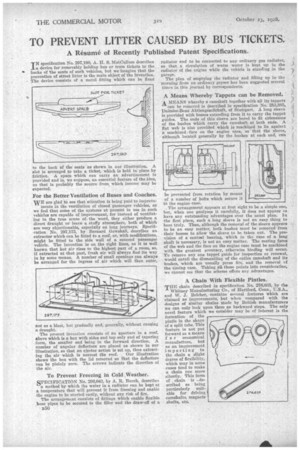TO PREVENT LITTER CAUSED BY BUS TICKETS.
Page 34

If you've noticed an error in this article please click here to report it so we can fix it.
A Résumé of Recently Published Patent Specifications.
IN specification No. 297,190, A. U. S. MdeCullum describes a device for removably holding bus or tram tickets to the
• backs of the seats of such vehicles, but we imagine that the prevention of street litter is the main object of the invention. The device consists of a metal fitting which can be Axed to the back of the seats as shown in our illustration. A slot is arranged to take a ticket, which is held in place by friction. A space which can carry an advertisement is provided and is, we suppose, an essential feature of the idea, as that is probably the source from which income may be expected.
For the Better Ventilation of Buses and Coaches.
WE are glad to see that attention is being paid to improve
ments in the ventilation of closed passenger vehicles, as we feel that some of the systems at present in use in such vehicles are capable of improvement, for instead of ventilating in the true sense of the 'word, they either produce a direct draught or leave a stuffy atmosphere, both of which are very objectionable, especially on long journeys. Specification No. 297,175, by Bernard Gowshall, describes an extractor which can be fitted to a roof, or, with modifications, might be fitted to the side wall of a covered passenger vehicle. The invention is on the right lines, as it is well known that hot air rises to the highest part of a room, so, if extracted at that part, fresh air will always find its way in by some means. A number of small openings can always be arranged for the ingress of air which will then enter,
not as a blast, but gradually and, generally, without causing a draught.
The present invention consists of an aperture in a roof, above which is a box with sides and top only and of tapering form, the smaller end being in the forward direction. A number of angular deflectors are placed as shown in our illustration, so that an ejector action is set up, thus extract ing the air which is nearest the roof. Our illustration shows the box with the lid removed so that the deflectors can be plainly seen. The arrows indicate the direction of the air.
To Prevent Freezing in Cold Weather, SPECIFICATION NO. 296,043, by A. R. Durch, describes a method by which the water in a radiator can be kept at a temperature that will prevent it from freezing and enable the engine to be started easily, without any risk of fire.
The arrangement consists of fittings which enable flexible hose pipes to be secured to the filler and the draw-off of a 1350
radiator and to be connected to any ordinary gas radiator, so that a circulation of warm water is kept up in the radiator of the enginewhile the vehicle is standing in the garage.
The plan of emptying the radiator and filling up in the morning from an ordinary geyser has been suggested seyeral times in this journal by correspondents.
A Means Whereby Tappets can be Removed.
A MEANS whereby a camshaft together with all its tappets can be removed is described in specification No. 283,885, Daiinler-Benz Aktiengesellchaft, of Stuttgart. A long sleeve is provided with bosses extending from it to carry the tappet guides. The ends of this sleeve are bored to fit extensions of the bushes which carry the camshaft at both ends. A fiat webis also provided .which is machined to lie against a machined face on the engine case so that the sleeve, although located generally by the. hushes at each end, can
be prevented from rotation by means of a number of bolts which secure it to the engine case.
. The arrangement appears at first sight to be a sibyl° one, but, when one analyses it carefully, it does not appear io have any outstanding advantages over the usual plan. In the first place, such a long sleeve is not an easy thing to bore truly. Then, although the removal of the sleeve appears to be an easy matter, both bushes must be removed from their bosses to allow the sleeve to be taken out. The provision of a content bearing, which in the case of a long shaft is necessary, is not en easy matter. The mating feces of the web and the face on the engine case must be machined with the greatest accuracy, otherwise binding will occur. To remove any one tappet guide for inspection or renewal, would entail the dismantling of the entire camshaft and its bushes, which are usually press fits, and the removal ef the timing case. Taking all these points into consideration, we cannot see that the scheme offers any advantages.
A Chain With Flexible Pintles.
THE chain described in specification No. 276;633, by the
Whitney Manufacturing Co., of Hartford, Conn.. U.S.A.. and W. J, Reicher, contains several features which are claimed as improvements, but when compared with the designs of similar chains made by British manufacturers we can only look upon them as backward steps. The only novel feature which we consider may be of interest is the formation of the pintle in the shape of a split tube. This feature is not put forward as a means f o r economical manufacture, but as an improvement imparting to the chain a slight degree of flexibility, which may in some cases tend to make a chain run more silently. This form of , chain is --described as being particularly suit, able for driving 1 camshafts, magneto shafts, etc.•


































